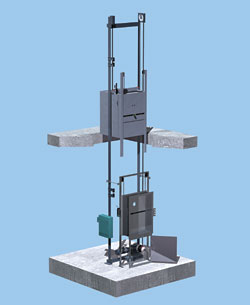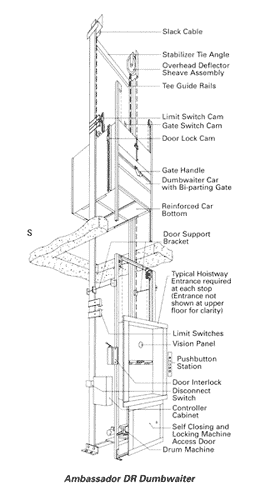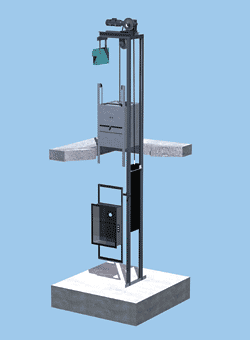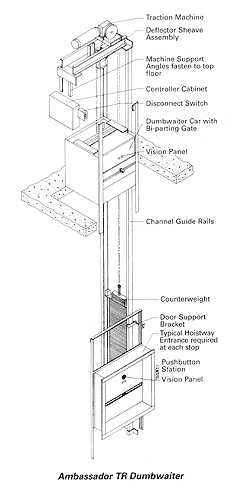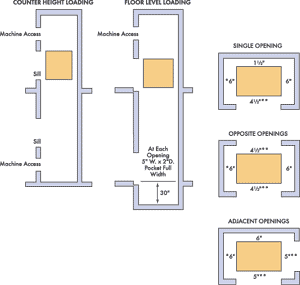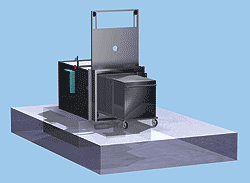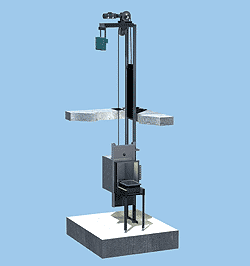Vertical Materials Handling Systems aka Dumbwaiters
Once a simple hoist mechanism, the dumbwaiter is now the smart, efficient, safe and economic solution for moving materials from one floor to another.
![]() Continuing Education
Continuing Education
Use the following learning objectives to focus your study while reading this month’s Continuing Education article.
Learning Objectives - After reading this article, you will be able to:
- Have a general knowledge of different vertical material handling systems and when to use them.
- Identify key design and planning criteria.
- Discuss the benefits of using vertical material handling systems.
Once a simple hoist mechanism, the dumbwaiter is now the smart, efficient, safe and economic solution for moving materials from one floor to another.
Since the late 18th century when Jefferson adopted the French custom of using several of them for dinner parties, the dumbwaiter has joined our lexicon. It has saved labor and efficiently solved the eternal challenge of moving objects from one floor to another. But dumbwaiters of the twenty first century are a far cry from those hand-crafted European devices. For one thing, Jefferson's dumbwaiters, while certainly silent, did not move. Different from the wine elevators he installed on both sides of Monticello's dining room fireplace that led directly to the wine cellar below, they were small free-standing tables whose several shelves held food, dishes and silver. Placed beside each guest, they replaced curious servants or slaves and were intended to encourage free and unrestricted conversation. Another difference is that today's dumbwaiter-despite its name-is smart, a significantly less costly alternative to the elevator, employs state of the art technology and promotes safety. While the elevator has generated a body of knowledge-it even has its own online museum-the dumbwaiter has been virtually ignored despite its long-time use in a multitude of building types.
Over the years, the dumbwaiter has lent its name to a group of products known as vertical materials handling systems-systems that have proven adaptable to any situation in which goods of any kind-but not people-are moved from floor to floor in multi-story buildings.
Promoting Economy, Safety and Efficient Use of Space
It "saves miles of steps for busy feet," announces a 121-page brochure from a former Chicago dumbwaiter manufacturer dated 1914. Inside are abundant photographs of virtually every major hotel, club, hospital, restaurant, department store and office in the country that had acquired one of its electrified systems. The company added the cogent argument that its system also saved money, "don't waste the valuable time of high priced help in running up and down stairs with goods." While the cost of help in 1914 must appear ludicrously low in today's dollars, the point is particularly relevant today. Dumbwaiters create payback efficiencies. Passenger elevators are not tied up with the transportation of materials and can therefore accomplish the purpose of moving people quickly and efficiently. Since they do not need to walk around or up and down stairs delivering materials along with obligatory pleasantries, employees are able to stay in their offices and their workstations. The calculation of a hypothetical situation makes a striking point. If ten employees whose average salary and benefits amount to $35 per hour make three 20-minute trips per day, the cost to their employee is $3,500 per week.
Safety is another benefit. With the appropriate choice of product, employees avoid dangerous misuse of equipment such as fork lifts and chain hoists. Employees pushing, pulling, carrying and lifting often cause accidents, falls, bumps and injuries. In addition to time lost through hours and days off, there are additional costs incurred in related paperwork, reports and possible litigation. The Bureau of Labor Statistics reports that in 2003, sprains and strains accounted for 43 percent of injuries resulting in days away from work in the private sector- evidence that appropriate materials handling positively contributes to safety and welfare for all partiesDumbwaiters also save space and cost less than their alternatives. Depending upon configuration and the type of lift, initial total installed costs are approximately 40 percent to 60 percent less than that of a passenger or freight elevator. In terms of square footage of a building floor plan, they require 50 to 75 percent less than that taken up by an elevator. This translates into significant useful space that can be allocated to the original purpose of the building. They also have both a long life and-at 25 years-a long modernization cycle.
Different Types of Systems: Dumbwaiters
There are two major groups of vertical material handling systems: dumbwaiters and conveyors.
Dumbwaiters are restricted in size of platform (10.75 square feet) and clear inside height (4-feet). Code regulations state they must have a minimum capacity of 13.9 lbs. per cu. ft of internal area, but no maximum capacity; they are, however, generally built with a capacity of 100 lbs. to 500 lbs. They are usually enclosed within a fire-rated hoistway or shaft and equipped with fire-rated hoistway entrances. They can be equipped with power operated hoistway entrances and automatic loading and unloading conveyors at landings. They can also stop at floor level for the transport of wheeled carts or at table or counter height for hand loading. Dumbwaiters are allowed by code to have machines within and adjacent to the hoistway. They are regulated by the elevator code (ANSI 17.1).
Depending upon requirements of speed, capacity and travel distance, dumbwaiters use one of two types of hoisting mechanisms: winding drum and traction. Thewinding drum dumbwaiter raises and lowers the car by wrapping and unwrapping the hoist rope on cylindrical steel grooved drum located at the top or bottom of the lift shaft.
- Ideally suited for heavy-duty use in medium or low-rise applications.
- Maximum speed of 50 feet per minute.
- Capacity is usually 100 lbs. to 500 lbs.
- Height limitation is usually 50 feet. Larger travel distances are possible with custom design.
- Space required above the car at upper landing usually varies between 42-inches and 60-inches if the machine is located at the top. Space required at upper landing if the machine is located below depends upon the height and type of entrance door used.
- Car dimensions can vary according to client needs.
- Machines for floor loading dumbwaiters are mostly located at the top, but in some situations such as clean rooms, can be located at lower landings adjacent to and at the sides of the hoistway. Machines for counter-height loading dumbwaiters may be located inside the hoistway and below the counter-height.
- Its heavy-duty guide rails can span 12-feet floor heights without requiring intermediate brackets or tower support, allowing the use of lightweight, non-load bearing shaft walls.
- Hoistway clearances (see diagram A)
- An ideal choice for adding onto existing structures.
- The least expensive system with minimal maintenance.
|
Thetraction dumbwaiter machine, commonly located at the top of the lift shaft, turns a pulley called a traction sheave. Hoist cables run over the top of the sheave and drop on one side to the car and on the other side to a counterweight. When the car goes up, the counterweight goes down, and vice versa. The use of a counterweight allows less energy to be expended.
- Usually used in higher rise and higher speed applications.
- Speed is 50 to 300 feet per minute.
- Capacity is usually 100 lbs. to 500 lbs., but can accommodate more.
- Machines are mostly located at the top, but, in some situations
such as clean rooms, can be located at lower landings adjacent
and at the sides of the hoistway.
- Space required above the car at upper landing varies between 48-inches and 66-inches.
- It offers floor-level loading or counter-height loading capability.
- Hoistway clearances (see Diagram A)
- Counterweighted traction design employs high-rise elevator technology. State of the art microprocessor controls allow custom programmed operations.
- More expensive than winding drum or hydraulic systems.
The most valuable benefit of dumbwaiter systems is their seemingly never-ending usefulness in today's many building types. Found in restaurants, universities, clinics, hotels, hospitals, libraries, office buildings, warehouses, retail stores, clean room manufacturing, laboratories, airports, banks and courthouses, they can be configured for file distribution and trendy sportswear showrooms to prisons and four-star restaurants.
|
Sometimes they serve as a simple inexpensive substitute for an elevator. DiMarinisi & Wolfe Architects and Urban Designers designed a new state police station in Dartmouth, MA. The many boxes of documents and files were to be stored in the attic of the single story building. Options for transporting them included an elevator or a dumbwaiter. Since there was no need to transport people to the attic, partner Maury Wolfe, AIA, specified a dumbwaiter.
At other times they offer a simple solution to a design problem. For the expansion and renovation of the Dana Athletic Center, Bentley College, Waltham, MA, Jeffrey Millman Associates with Add Inc created a formal dining room on the second floor above the main dining space and kitchen. The problem was how to transfer the food from the kitchen to the satellite serving space above. The footprint was small and the existing elevator conveniently near the fitness area. So rather than relocate the elevator, reports project manager KyAnn Anderson of Add Inc, the team chose to send out a preconstruction bid for a dumbwaiter.
|
Other situations require new ways of solving old demands. During its fifteen years of working on eighty-plus court related projects, Moselely Architects of Richmond, VA, was frequently asked to install a pneumatic tube system (PTS). Used for delivering documents, a PTS requires an air compressor and 4-inches or greater tubing diameter bent in radiuses of approximately 48-inches. In recent years there have been fewer requests for a PTS, reports senior associate Ronald D. Crouch, AIA. With the greater use of computers and digital scanning, documents could be retrieved easily on screen. But when Moseley undertook the renovation and expansion of the Juvenile and Domestic Relations Court in Charlottesville, VA, the experienced clerk of the court asked for a document transfer system. Judging by the size of the sample documents, the 4-inch PTS tube was not large enough. Instead, the firm specified a dumbwaiter-for the first time, Crouch believes.
Selecting one with a winding drum mechanism-the smallest and simplest available-the firm created a gypsum wallboard type shaft, which required code compliance just as with a stair or elevator application. Since the old wood flooring was being replaced, there was minimal impact on the structural design of the floors. Because access to the machine was placed at the lowest level opening instead of above the car, a fire rated access door was required. Crouch points out the importance of having the controls and bottom of the opening accessible for people with handicaps.
|
Dumbwaiter Speeds, Capacity and Travel Limitations
|
||||||||||||||||||||
The Planning Process
While each project is unique, the planning process for specifying dumbwaiter systems includes the same key decisions. There is a logical order to the process, but building constraints such as the space available above the car on the upper landing, may dictate the choice of lift. Fortunately for those familiar with the former MasterFormat numbering system, there is little new to learn in the new MasterFormat 2004 Edition. All Conveying Equipment remains in Division 14 with Conveying Equipment assigned to 14 00 00 and Dumbwaiters assigned to 14 10 00.
|
The planning steps are:
- Determine whether the dumbwaiter will stop at floor level or counter height.
- Note hoistway or shaft clearances (Diagram A).
- Determine space requirement above the car at the upper landing.
- Determine the limitations of travel and speed according to the project requirements.
A rule of thumb for selecting speed requirement for medium and high-rise applications: the traveling time between terminal landings should never exceed 30-45 seconds.
On speeds exceeding 100 feet per minute, variable voltage equipment will often be required.
- Determine whether guide rails should be bracketed to the walls and floor slabs (required load-bearing or reinforced hoistway walls) or furnished with a full, self-supporting, angle tower, permitting use of less expensive wall construction. (Most local building codes require shaft walls to have a two-hour fire rating.)
- Determine machine location. Traction dumbwaiter machines are usually located at the top. Machines for winding drum floor loading dumbwaiters are commonly located at the top, but with a counter-height loading model, they may be placed in the hoistway below the counter-height. In special situations such as clean rooms, machines for both winding drum and traction type dumbwaiters may be located at lower landings at either side of the hoistway
- Select lift model.
Example of specifications for traction dumbwaiter
Part 1 - General 1.1
Section Includes
A. Furnish and provide all materials and labor necessary for the complete installation of one commercial traction dumbwaiter.
B. Obtain information on conditions affecting work at jobsite, including verification of dimensions, field material for anchoring, accessibility and storage space. Verify voltages and outlets on electrical drawings.
|
1.2 Work Done By Others
A. Suitable, legal, two-hour fire rated hoistway, if consistent with building construction.
B. Hoistway door walls must not be erected until doors are set in place.
C. Electrician shall furnish power supply with line disconnect switch immediately adjoining the controller cabinet.
D. Hoistway free of all pipes and obstructions.
E. All bracket fastening inserts and other steel required for support of guide rails and brackets.
F. Painting of exterior walls and prime finished components which are exposed to view, including inside of car, car gates and doors.
G. Machine area lighting and convenience outlet.
1.3 References
Design and installation shall be in compliance with regulations and all governing agencies. Lift shall be subject to local, city and state approval prior to installation, along with city and state inspection after installation. Special local requirements shall be determined and handled locally by distributor with manufacturer's agreement.
1.4 Submittals
Submit drawings or manufacturer's literature for approval. Drawings shall show rough-in requirements and wiring materials.
1.5 Substitutions
No substitutions will be considered unless written request for approval has been submitted by the bidder and was received by the architect at least ten (10) days prior to the date of receipt of bids. Each such request shall include the name o the materials for which it is to be substituted and a complete description of the proposed substitute including drawings, cuts, performance and test data, a list of projects of similar scope, photographs of existing installations and any other information necessary for evaluation.
1.6 Testing
The dumbwaiter shall be tested after installation to demonstrate:
- Accuracy of stops
- Operation of hoistway door locks and car gate switch (es).
- Operation of final terminal switches
- Operation of push-button and key switches
- Capacity load test. Operate dumbwaiter for a period of twenty (20) minutes with a capacity load. Run dumbwaiter from top terminal floor to bottom floor with one minute between starts after each stop.
PART 2 - PRODUCTS
2.1 Manufacturer
Name of manufacturer
2.2 Product Type
A. Model shall be the commercial traction dumbwaiter
B. Car shall have clear inside dimensions of ________ inches wide x _______ inches deep x ________ inches high, and have one removable shelf. Capacity to be ________ pounds. Dumbwaiter to serve _______stops and ___________ openings, located on ( ) same, ( )opposite, ( ) adjacent side(s) of the hoistway. The car shall stop at ( )counter-height or ( ) floor level. The travel distance shall be ____________ feet. Power supply shall be _______volt, 3 phase, ___________ hertz.
C.All equipment shall be manufactured in accordance with the latest edition of the ANSI 17.1 code for elevators, escalators, and dumbwaiters.
2.3 Fabrication
A. Car Enclosure: The car shall be constructed of 16 gauge ( ) #4 satin polished stainless steel or ( ) carbon steel with a prime finish. Car shall have one removable shelf. An electrical light fixture shall be recessed in the ceiling. Floor loading models shall have a reinforced floor.
B. Car Gates: The car shall be equipped on each open side with a gate matching the car construction and finish. The gate shall be vertical ( ) bi-parting or ( ) slide up design. Car gate(s) shall be manually operated unless power operation is specified.
C. Guide Rails: Steel channel rails 2 7/8"wide x 1 3/4" deep and 1/4" flange shall be furnished to guide the car. Guide rails shall be mounted to the floor slabs and hoistway wall with steel brackets.
D. Machine: Machine shall be the traction type. Motor shall be of ample horsepower to lift the rated load at the rated speed, with a high starting torque and low starting current. It shall be equipped with a spring applied and electrically released brake. Machine shall be located at the top of the hoistway and mounted on structural steel base. The traction sheaves shall be semi-steel, with machine grooves designed to provide adequate traction, and long cable life.
E. Controller: Controller shall be wall mounted type with lockable door, located on hoistway outer wall in sight of machine access door. Controller shall be solid state programmable and Underwriter's Laboratories, Inc. listed.
F. Operational Control: Operation shall be automatic call and send. A pushbutton station with one button for each level served, shall be furnished at each door. It shall be possible at each level to call the car or send it to any other level. Pushbuttons shall be inoperative while car is in transit, and for a few seconds after arrival at the selected level. Pushbuttons shall have stainless steel faceplates.
G. Signals Devices:
- "Door Open" call buzzer shall sound when a pushbutton is pressed and a hoistway door or car gate is open.
- "Car Here" light and chime - shall be located in each pushbutton station. Chime shall indicate car arrival. Light shall indicate car presence.
- Combination "Door Open" and "In-Use" light - shall be located in each pushbutton station. Light will illuminate when car is in transit and when a pushbutton is pressed and a hoistway door or gate is open.
|
H. Leveling Accuracy: If the car stops above the floor level, car floor shall be no more than 1/2" above or below the level of the hoistway door sill. If car stops at floor level, car floor shall be no more than 1/4" above or below the level of the hoistway door sill.
I. Hoist Ropes. Minimum (2, 1/4" x 3 x 19) traction steel cable with safety factor per code.
J.Final Limit Stopping Devices: Provide per code
K. Guide Shoes: Guide shoes shall be adjustable, renewable dry type.
L. Hoistway Doors: Door shall be vertical sliding ( ) bi-parting or ( ) slide up design. Each door shall bear the Underwriters "B" label and shall be rated for application in;(a) masonry shaft or (b) metal stud drywall shaft. Hollow metal door panels shall be 16 gauge ( ) stainless steel with satin polish & No. 4 finish or ( ) carbon steel with prime finish. Welded unit wall frame, including jambs, trim and sill shall be; 16 gauge ( ) stainless steel with satin polish & No. 4 finish or ( ) carbon steel with prime finish. Doors shall be manually operated unless power operation is specified. A door lock and contact shall be provided on each door.
M. Machine Access Door: Hinged access door shall be 24" w x 24" h and shall be furnished at machine location for service and maintenance. Access door shall be 16 gauge ( ) stainless steel with satin polish & No. 4 finish or ( ) carbon steel with prime finish.
N. Counterweight: The counterweight shall be equal in weight to that of the car plus 40% of the rated capacity.
O. Drawbridge (Optional): Floor loading models with bi-parting door and car gates shall be equipped with drawbridge to provide smooth entrance for wheeled carts. Drawbridge shall be raised and lowered by opening and closing of car gate.
P.Self-Supporting Tower (Optional): Components shall be carried on a self-contained, rigidly braced, structural steel angle tower. Tower must be braced by building structure.
Q. Power-Operated Hoistway Doors and Car Gate(s) (Optional): Car gate(s) shall be motorized, and shall be equipped with magnetic clutch assembly which shall power operate the hoistway doors.
A. Rated load _________ pound capacity
B. Minimum travel speed shall be _________________ F.P.M
- If rated speed is 50 F.P.M. drive and control shall be single speed A.C.
- If rated speed exceeds 50 F.P.M., drive and control shall be variable voltage, variable frequency A.C.
C. Leveling Accuracy: Car floor shall be no more than 1/2" above or below the level of the hoistway door sill.
Part 3 - Execution 3.1
Installation
A. Coordinate work with General Contractor.
B. Leave standard electrical connection drawings with electrical contractor to make final electrical connection. Wiring within unit shall be done as part of work of the is section, 20 amp circuit required.
C. The installation of the dumbwaiter shall be made in accordance with the approves plans and specifications and manufacture's installation instructions
Different Types of Systems: Vertical Reciprocating Conveyors
Vertical reciprocating conveyors are vertical lifts designed for large scale, higher-speed delivery of heavy or bulky materials (the term ‘reciprocating' indicates that the conveyor moves up and down). They can be utilized in either commercial or industrial applications but cannot be exposed to or used by the general public. In commercial buildings a conveyor is usually contained within a fire-rated shaft with fire-rated hoistway entrances. In industrial applications it is often protected by sheet metal barriers, which have no fire rating. Conveyors are regulated by ASME B.20.1 safety standard.
- Virtually unlimited travel distance.
- Speeds up to 300 feet per minute.
- Load capacity up to 2000 lbs.
- Platform size up to 52-inches x 52-inches.
- Loads from floor or platform height.
- Can be manually loaded or installed with optional transfer device for automatic load/unload, or for interfacing with automated material handling systems.
- Options include carriage enclosure; power-operated guard doors; touch screen control module.
- Self-supporting.
- Modular construction.
Conveyors may be specified with aroped hydraulic lift equipment for low speed and medium rise applications. They offer the least expensive means to raise heavy loads and the design advantage of having a machine that is located outside but adjacent to the hoistway at the rear or side of the car. The hydraulic system works by pumping oil into a cylinder, which causes a jack to rise. Stationary cables attached to the car pass over the sheave on top of the jack. When the jack rises, the cables hoist the car and vice versa. Unlike a direct action hydraulic system, no deep hole is needed to sink the hoistway at the rear or side of the car. Hydraulic lifts costs are in the medium range.
|
Conveyors present a cost effective solution to providing access to all levels of a building by requiring minimal floor space. They have been used for manufacturing, warehousing, distribution, food processing, mezzanine lifts and pallet lifts. In addition to their application across a broad range of commercial and industrial sectors, they offer a number of configurations for different functions.
Their advantages include:
- Expendable, reprogrammable equipment.
- Open or enclosed load platform.
- A wide variety of enclosures.
- May be configured for use in sanitary settings such as hospital food service, sterile supply environments and clean rooms.
- Optional fire rated access doors and UL rated controls.
Different Types of Systems: Vertical Material and Cart Handling
Vertical material and cart handling systems are designed for large scale, high-speed delivery of heavy or bulky materials and can be designed for low, medium, or high-rise applications that need to make high-speed transfers. Carts may be manually loaded or provided with automatic loading and unloading equipment. They are powered hydraulically, by winding drum, or by traction, and are regulated by either conveyor safety ASME B.20.1 or ASME 17.1 elevator code.
- Doors can be manually operated swing type, power, or manually operated vertical bi-parting type hoistway doors.
- Car sizes up to 36-inches wide x 72-inches front to back x 80-inches high.
- Fire-rated hoistway, pit, and machine room required for some applications.
With either open or enclosed load platforms, cart systems may be configured for use in sanitary applications, hospital, food service, sterile supply environments, clean rooms. surgical carts, supply carts, manufacturing, laundry, food service and bulk handling.
|
Table of Dumbwaiter Speeds-Capacity-Travel
|
They also offer a convenient means for achieving the best use of prime space. When the Gould Tanner Group of Nashville embarked on an addition and renovation for the Bayshore Medical Center in Pasadena, Texas, it needed to expand outpatient surgery and add operating rooms on the first floor. In the existing footprint, central sterile was also on the first floor, a convenient cart trip away from the operating rooms. In order to locate the new surgery rooms on the first floor, explains Matt Rigsby, AIA, project coordinator, central sterile needed to be moved. The solution was to put it in the basement and use two sets of cart handling systems to deliver and fetch the clean and dirty materials. Although the distance was just one floor, traction motors were specified for faster speed.
Different Types of Systems: Automatic Delivery
An alternative to manual distribution, automatic delivery dystems handle small loads 100 lbs. or less and are cost effective because there is no loading, unloading or waiting. They are used to handle pharmaceuticals and patient files in hospitals, mail and file distribution in offices, and inventory and file distribution in manufacturing facilities. Automatic systems employ either dumbwaiter or conveyor technology depending upon travel and speed requirements. The automatic dumbwaiter is regulated by elevator code (ANSI 17.1). Exempt from elevator code, the automatic conveyor is regulated by conveyor code (ASME B20.1)
|
- Speed from 50 to 300 feet per minute
- Capacity 100 lbs. or less
- Travel limitation none.
- Easily installed in new and existing structures
- Requires minimal floor space.
- Loads may be simultaneously dispatched from and sent to any user station.
- Can be expanded and reprogrammed to meet changing material flow requirements.
Example of specifications for vertical reciprocating conveyor (with winding drum mechanism).
PART 1 - GENERAL
1.1 Section Includes
A. Furnish and provide all materials necessary for the complete installation of one (manufacturer) Vertical Reciprocating Conveyor.
B.Obtain information on conditions affecting work at jobsite. Including verification of dimensions, field material for anchoring, accessibility and storage space. Verify voltages and outlets on electrical drawings.
|
1.2 Work Done By Others
A. Electrician shall furnish a properly protected power supply of sufficient capacity.
B. Provide support and bracing for the framework and enclosure.
1.3 References
Design shall be in compliance with the A.S.M.E. B.20.1 standard. Special local requirements shall be determined and handled locally by dealer with manufacturer's agreement.
1.4 Submittals
Submit drawings or manufacturer's literature for approval. Drawings shall show equipment dimensions and clearance requirements.
|
Chart for Automatic Delivery Systems
|
1.5 Substitutions
No substitutions will be considered unless written request for approval has been submitted by the bidder and was received by the specifier at least ten (10) days prior to the date of receipt of bids. Each such request shall include the name of the materials for which it is to be substituted and a complete description of the proposed substitute including drawings, cuts, performance and test data, a list of projects of similar scope, photographs of existing installations and any other information necessary for evaluation.
1.6 Testing
The conveyor shall be tested after installation to demonstrate:
- Accuracy of stops
- Operation of door locks
- Operation of push-button and key switches
- Capacity load test
- All safety devices and circuits are functional.
PART 2 - PRODUCTS
2.1 Manufacturer
Name of manufacturer
2.2 Product Type
A. Model shall be the (name of product). The Vertical Reciprocating Conveyor shall consist of a structural steel framework complete with machined vertical steel guide rails and expanded metal guard barriers at each landing to 8 feet high on all sides. The structure shall support a winding cable drum machine at the top. Overall lift capacity shall be ____ lbs. The carriage shall have platform dimensions of ___ inches wide x ___ inches front-to-back. The loading height of the carriage enclosure shall be ___ inches. Conveyor to serve ____levels and_____ openings, with a ( ) configuration or a ( ) configuration. Stops will be at ____ inches above the floor level. The travel distance shall be _____ feet _____ inches. Power supply shall be _______volt, 3 phase,_____ hertz.
B. All equipment shall be manufactured in accordance with the latest edition of the National Electrical Code and A.S.M.E. B.20.1 code for Conveyors and Related Equipment.
2.3 Fabrication
A. Carriage: The carriage shall be of fabricated steel construction.
B. Guide Rails: Precision machined steel rails shall be furnished to guide the carriage.
C. Machine: Machine shall be the winding drum type mounted on a steel frame at the top of the structure. Motor shall be of ample horsepower to lift the rated load at the rated speed. It shall be equipped with a spring applied and electrically released brake. The drum shall have precision machined grooves designed to provide long cable life.
D. Controller: NEMA 12 Controller enclosure shall be equipped with lockable door and electrical disconnect. Controller shall be solid state, programmable and Underwriter's Laboratories, Inc. listed.
E. Operational Control: Operation shall be automatic call and send. A pushbutton station wit one button for each landing served shall be furnished at each door. It shall be possible at each landing to call the car or send it to any other landing. Pushbuttons shall be inoperative while car is in transit and for a few seconds after arrival at the selected landing.
F. Leveling Accuracy: Carriage platform shall be no more than _" above or below the landing door sill.
G. Hoist Ropes. Provide aircraft type steel hoist cable with a minimum 7:1 safety factor.
H. Entrance Guard Doors: Doors shall be vertical sliding bi-parting or single panel slide-up. Each door shall be equipped with an interlock to prevent the carriage from moving unless the door is closed and locked. Metal door panels shall be expanded metal.
I. Manuals: Provide required instruction manuals, diagrams and parts lists necessary for operation and maintenance of system.
2.4 Performance
A. Rated load ____lb. capacity
B. Travel speed shall be ____ F.P.M.
2.5 Options
A. Fire Rated Entrance Doors: Entrance doors shall bear the Underwriter's Laboratory "B" label and shall be rated for installation in masonry or stud and drywall shaft.
B. Power Operated Entrance Doors: Entrance doors shall be power operated. The door shall open automatically upon arrival of the carriage at a landing. The door shall automatically close when the carriage is dispatched to another landing.
C. Automatic Load and Unload: The carriage shall be equipped with a motorized transfer module for automatic loading and unloading of material at the landings. A motorized in-feed / receive conveyor station shall be located at each landing door for the automated dispatch and receiving of materials.
D. Automatic Unload Only: The carriage shall be equipped with a motorized transfer module for automatic unloading of material at the landings. A gravity roller conveyor station shall be located at each landing door for the automated receiving of materials.
E. Touch screen control console.
F. Inverter or vector drive allows smooth acceleration and deceleration and for speeds over 50 FPM.
PART 3 - EXECUTION
3.1 Installation
A. Coordinate work with appropriate trades.
B. Leave standard electrical connection drawings with electrical contractor to make final electrical connection. Wiring within unit shall be done as part of work of this section.
C. The installation of this conveyor shall be made in accordance with the approved plans and specifications and manufacturer's installation instructions.
|
Applications of Vertical Material Handling Systems
|
|
About Matot
|
||
|
Matot is the leading manufacturer of dumbwaiters in North America. Located in the suburbs of Chicago, the company has specialized in vertical material handling equipment since 1888 when its founder master carpenter Duffy Matot provided walk-in ice cooling equipment and manually operated dumbwaiters to taverns and shops on Chicago's north side. Today it offers a full line of equipment that includes winding drum and traction dumbwaiters, cart handling systems, automatic delivery systems and vertical reciprocating conveyors, in addition to residential elevators. Matot counts among its elevator industry clients companies such as Otis, ThyssenKrupp, Kone and Schindler. Still a family owned business, its equipment is found in virtually every sector of industrial and service sectors from hospitals and offices to airports and clean rooms. For more information on vertical material handling systems, contact Matot Inc. at (800) 369-1070 or visit the web site atwww.matot.com
|

